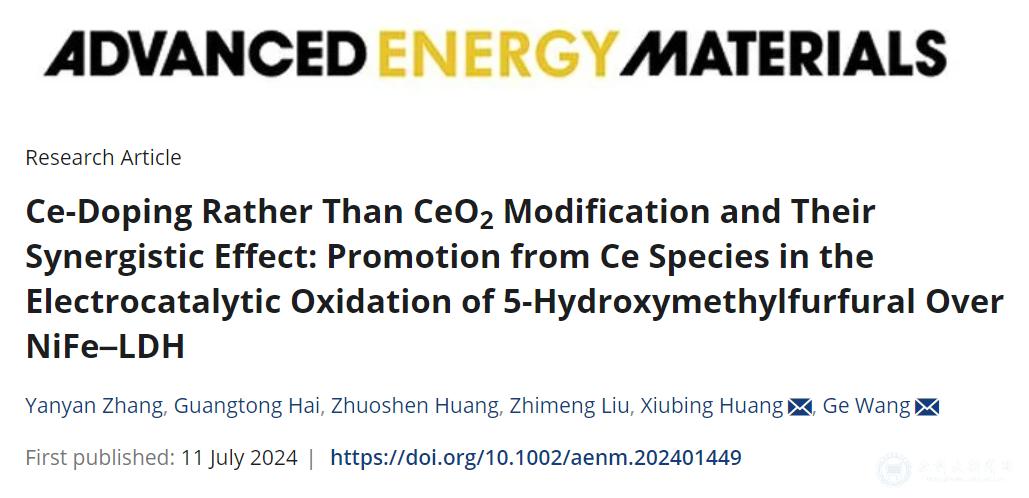USTB is committed to building itself into a high-level research-oriented university
which attaches importance to novel scientific research and promotes independent innovation.
Rare earth elements, often referred to as the “industrial gold,” are prized for their outstanding photoelectric, magnetic, and other physical properties. They enable the synthesis of various advanced materials and significantly improve the quality and performance of numerous products. China is both the world’s largest rare earth reserve holder and the leading producer. The Baiyun Obo deposit in Baotou, Inner Mongolia, is the largest rare earth mine in the world, accounting for more than 80% of the nation’s total reserves, earning the region the title of “Capital of Rare Earths.”

The relevant achievements were published in the top international journal "Advanced Energy Materials"
Cerium (Ce), one of the most abundant rare earth elements, has unique redox properties stemming from its Ce³⁺/Ce⁴⁺ couple. With excellent oxygen storage and electron/proton conductivity, Ce has been widely applied in various catalytic fields.
Recently, Professor Xiubing Huang’s team and Professor Wei Wang’s group from the School of Materials Science and Engineering published their latest research in the top international journal Advanced Energy Materials. Their article, titled “Ce-Doping Rather Than CeO₂ Modification and Their Synergistic Effect: Promotion from Ce Species in the Electrocatalytic Oxidation of 5-Hydroxymethylfurfural Over NiFe–LDH”, presents new insights into cerium-based catalytic materials. The first author of the paper is Zhang Xinyu, a 2021 doctoral student from the School of Materials Science and Engineering, University of Science and Technology Beijing.
Research Background
Over the past years, Professors Wang and Huang’s teams have conducted extensive studies on Ce-based nanomaterials, covering areas such as rational material design, controlled synthesis, and catalytic applications. Their contributions include work on low-temperature gas-phase catalysis (Chem. Eng. J., 2023), thermal catalysis and organic synthesis (Chin. J. Catal., 2024; ACS Catal., 2021), electrocatalytic water splitting (Appl. Catal. B-Environ., 2021), and energy-related electrocatalysis (J. Power Sources, 2020; ACS Sustainable Chem. Eng., 2019).
5-Hydroxymethylfurfural (HMF), derived from C6 biomass carbohydrates, is a crucial platform chemical. Its oxidation product, 2,5-furandicarboxylic acid (FDCA), is a sustainable alternative to petroleum-based terephthalic acid in producing renewable bioplastics. Due to HMF’s high valorization potential, the team systematically explored the effect of CeO₂ modification on transition-metal catalysts for HMF electrooxidation (Adv. Funct. Mater., 2023; Appl. Catal. B-Environ., 2023).
Their recent study demonstrates that Ce doping, rather than conventional CeO₂ modification, plays a decisive role in enhancing NiFe-LDH nanosheet catalytic activity for HMF oxidation. This work provides fresh insights into catalyst design strategies for biomass valorization.
About the Authors
Prof. Xiubing Huang is a doctoral supervisor at the School of Materials Science and Engineering. He received his B.S. and Ph.D. degrees from the University of Science and Technology Beijing in 2008 and 2011, respectively. He later studied at the University of St Andrews, UK, and completed postdoctoral research at Nagoya University, Japan, and Ruhr University Bochum, Germany. His research focuses on the rational design and controlled synthesis of functional nanocomposites, particularly for energy storage and catalytic applications. Prof. Huang has presided over numerous national research projects, including those funded by the National Natural Science Foundation of China and the Ministry of Science and Technology. He has published over 120 SCI papers (80 as first or corresponding author), with an H-index of 46 and more than 7,200 citations.
Prof. Wei Wang is also a faculty member of the School of Materials Science and Engineering. He obtained his Ph.D. in Chemical Engineering from Michigan Technological University in 2002. Prof. Wang was selected for the Beijing “Science and Technology New Star” program in 2002 and has since received numerous honors, including the “Outstanding Mid-Career Scientist” award (2013) and the “National Ten Major People of the Year in Metallurgical Education System” award (2015). He has led over 30 major national research projects, including the 863 and 973 programs, and published more than 300 SCI papers with over 70 patents. His research is centered on efficient energy conversion and advanced catalytic materials.
Prof. Wang’s team has also received multiple awards, including the Second Prize of the National Natural Science Award (2011) and the First Prize of the Beijing Municipal Natural Science Award (2012)